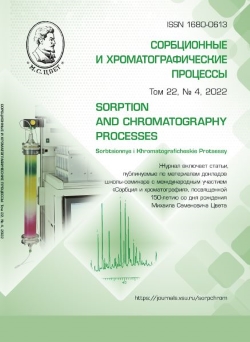Identification of the components of an ozonated pyrolysis liquid through the use of gas chromatography-mass spectrometry, ion liquid as a stationary phase, and machine learning
Abstract
Pyrolysis is one of the methods for recycling plastic. Depending on the conditions of the process, pyrolysis usually results in the formation of a volatile liquid fraction (pyrolysis liquid) and a non-volatile solid or resinous precipitate. Pyrolysis followed by the processing of the liquid fraction is a widely used and is a thoroughly studied technique. Ozonation (oxidation with an ozone-air mixture) can be the focus of further research in the processing of pyrolysis liquids. After the ozonation of a pyrolysis liquid, the obtained mixture contains both hydrocarbon and oxygen-containing compounds.
The purpose of our study was to identify the components of the mixture formed as a result of ozonation of the liquid fraction obtained by the pyrolysis of plastic using gas chromatography-mass spectrometry and machine learning methods. In order to do this, we used a stationary phase based on an ionic liquid. To exclude false candidates when searching the mass-spectral database, we used a new model for the prediction of retention indices on various stationary phases. In our study we used a sample obtained by the ozone treatment of a pyrolysis liquid for a long period of time. The analysis of the sample was performed by means of gas chromatography-mass spectrometry using a Shimadzu GCMS-TQ8040 (Shimadzu) instrument. To analyse the sample, we used a column based on pyridine ionic liquid Bis4MPyC6 (30 m, 0.22 mm×0.2 μm). To predict the retention indices, we used a universal machine learning method which uses retention indices predicted by preliminary trained neural networks for standard polar and nonpolar phases as the input variables. The search for the mass spectra in the NIST database resulted in the incorrect identification of practically all the compounds in the studied mixture. Prediction of the retention index allowed us to determine the composition of the mixture.
Thus, we managed to identify the products of plastic pyrolysis followed by ozone treatment by means of gas chromatography-mass spectrometry and machine learning. The study demonstrated that a stationary phase based on the ionic liquid Bis4MPyC6 can be used to separate both polar and nonpolar compounds contained in the studied mixture.
Downloads
References
Geyer R., Jambeck J.R., Law K.L. Production, use, and fate of all plastics ever made. Sci. Adv., 2017; 3(7): e1700782. https://doi.org/10.1126/sciadv.1700782
Qureshi M.S., Oasmaa A., Pihkola H., Deviatkin I., Tenhunen A., Mannila J., Minkkinen H., Pohjakallio M., Laine-Ylijoki J. Pyrolysis of plastic waste: Opportunities and challenges. Journal of Analytical and Applied Pyrolysis. 2020; 152: 104804. https://doi.org/10.1016/j.jaap.2020.104804
Lombardi L., Carnevale E.A. Evaluation of the environmental sustainability of different waste-to-energy plant configurations. Waste Management. 2018; 73: 232-246. https://doi.org/10.1016/j.wasman.2017.07.006
Anuar Sharuddin S.D., Abnisa F., Wan Daud W.M.A., Aroua M.K. A review on pyrolysis of plastic wastes. Energy Conversion and Management. 2016; 115: 308-326. https://doi.org/10.1016/j.enconman.2016.02.037
Gala A., Guerrero M., Guirao B., Domine M.E., Serra J.M. Characterization and Distillation of Pyrolysis Liquids Coming from Polyolefins Segregated of MSW for Their Use as Automotive Diesel Fuel. Energy Fuels. 2020; 34(5): 5969-5982. https://doi.org/10.1021/acs.energyfuels.0c00403
Rahman Md.M., Abd El-Aty A.M., Choi J.-H., Shin H.-C., Shin S.C., Shim J.-H. Basic Overview on Gas Chromatography Columns, Analytical Separation Science / ed. Pino V., Anderson J.L., Berthod A., Stalcup A.M., Weinheim, Germany: Wiley-VCH Verlag GmbH & Co. KGaA, 2015, pp. 823-834. https://doi.org/10.1002/9783527678129.assep024
Poole C.F., Poole S.K. Ionic liquid stationary phases for gas chromatography: Gas Chromatography. J. Sep. Science. 2011; 34(8): 888-900. https://doi.org/10.1002/jssc.201000724
Yao C., Anderson J.L. Retention characteristics of organic compounds on molten salt and ionic liquid-based gas chromatography stationary phases. Journal of Chromatography A. 2009; 1216(10): 1658-1712. https://doi.org/10.1016/j.chroma.2008.12.001
Liu J., Jiang G., Liu J., Jönsson J.Å. Application of ionic liquids in analytical chemistry. TrAC Trends in Analytical Chemistry. 2005. 24(1): 20-27. https://doi.org/10.1016/j.trac.2004.09.005
Vidal L., Riekkola M.-L., Canals A., Ionic liquid-modified materials for solid-phase extraction and separation: A review. Analytica Chimica Acta. 2012; 715: 19-41. https://doi.org/10.1016/j.aca.2011.11.050
Shashkov M.V., Sidelnikov V.N., Zaikin P.A. Selectivity of stationary phases based on pyridinium ionic liquids for capillary gas chromatography. Russ. J. Phys. Chem. 2014; 88(4): 717-721. https://doi.org/10.1134/S0036024414040268
Matyushin D.D., Sholokhova A.Yu., Karnaeva A.E., Buryak A.K. Various aspects of retention index usage for GC-MS library search: A statistical investigation using a diverse data set. Chemometrics and Intelligent Laboratory Systems. 2020; 202: 104042. https://doi.org/10.1016/j.chemolab.2020.104042
Matyushin D.D., Sholokhova A.Yu., Buryak A.K. A deep convolutional neural network for the estimation of gas chromatographic retention indices. Journal of Chromatography A. 2019; 1607: 460395. https://doi.org/10.1016/j.chroma.2019.460395
Qu C., Schneider B.I., Kearsley A.J., Keyrouz W., Allison T.C. Predicting Kováts Retention Indices Using Graph Neural Networks. Journal of Chromatography A. 2021; 1646: 462100. https://doi.org/10.1016/j.chroma.2021.462100
Matyushin D.D., Sholokhova A.Yu., Buryak A.K. Deep Learning Based Prediction of Gas Chromatographic Retention Indices for a Wide Variety of Polar and Mid-Polar Liquid Stationary Phases. IJMS. 2021; 22(17): 9194. https://doi.org/10.3390/ijms22179194
Matyushin D. Source code of software and parameters of pre-trained models. Available at: https://doi.org/10.6084/M9.FIGSHARE.14602317 (accesed 03 Juny 2022).
Sholokhova A.Yu., Patrushev Y.V., Sidelnikov V.N., Buryak A.K. Analysis of light components in pyrolysis products by comprehensive two-dimensional gas chromatography with PLOT columns. Talanta. 2020; 209: 120448. https://doi.org/10.1016/j.talanta.2019.120448
Weininger D., SMILES, a chemical language and information system. 1. Introduction to methodology and encoding rules. J. Chem. Inf. Model. 1988; 28(1): 31-36. https://doi.org/10.1021/ci00057a005
Kim S., Thiessen P.A., Bolton E.E., Chen J., Fu G., Gindulyte A., Han L., He J., He S., Shoemaker B.A., Wang J., Yu B., Zhang J., Bryant S.H. PubChem Substance and Compound databases. Nucleic Acids Res. 2016; 44(D1): D1202-D1213. https://doi.org/10.1093/nar/gkv951
Matyushin D. Pyridinium-based ionic liquids as gas chromatographic stationary phases: a data set for quantitative structure-retention relationships. Available at: https://doi.org/10.6084/M9.FIGSHARE.16885009 (accesed 03 Juny 2022).







